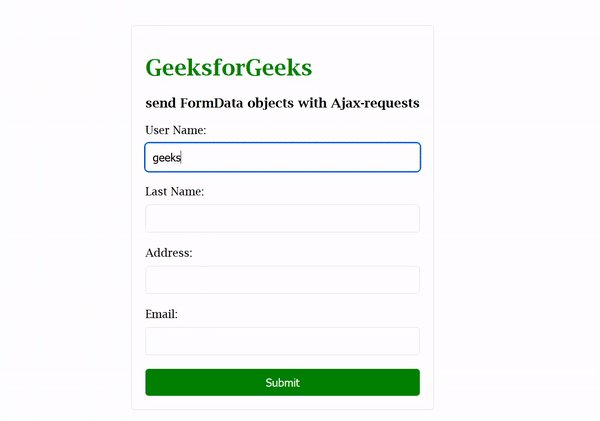

How to Send FormData Objects with Ajax-requests in jQuery ?
source link: https://www.geeksforgeeks.org/how-to-send-formdata-objects-with-ajax-requests-in-jquery/
Go to the source link to view the article. You can view the picture content, updated content and better typesetting reading experience. If the link is broken, please click the button below to view the snapshot at that time.

How to Send FormData Objects with Ajax-requests in jQuery ?
In this article, we will see how can we send formData objects with Ajax requests by using jQuery. To send formData, we use two methods, namely, the FormData() method and the second method is serialize() method. The implementation of Ajax to send form data enables the submission of data to the server without the need for a page refresh, which is a potent strategy applied in contemporary web-based applications to enhance the user’s interaction. The collection and transmission of form data with Ajax requests use FormData objects.
Syntax:
$.ajax({
url: "your-url",
type: "POST",
data: formDataObject,
processData: false,
contentType: false,
success: function(response){
// Handle success response
},
error: function(xhr, textStatus, error){
// Handle error response
}
});
Approach 1: The FormData()simplifies handling form data in JavaScript and jQuery by providing an easy way to construct and manage data from HTML forms, handle files and other complex form data, and automatically set the `Content-Type` header based on the content.
Example: In this example, this code shows how to use jQuery and Ajax to send form data to a server. The HTML form has four input fields (username, last name, address, and email), a submit button, and a unique ID “myForm”. The JavaScript code selects a form element by ID and sends its data as an Ajax request to “https://jsonplaceholder.cypress.io/posts” using jQuery’s $.ajax() function post method. Form data is sent using the “data” parameter of the Ajax request with disabled “processData” and “contentType” parameters. If the form is submitted, then it will show a success alert otherwise it will show an error message.
<!DOCTYPE html><html lang="en"><head><meta charset="UTF-8"><meta http-equiv="X-UA-Compatible" content="IE=edge"><meta name="viewport" content="width=device-width, initial-scale=1.0"><script src=</script><style>body {margin: 3rem;}#myForm {width: 400px;margin: 0 auto;padding: 20px;border: 1px solid #ddd;border-radius: 5px;}label {display: block;margin-bottom: 10px;}input[type="text"],input[type="email"] {width: 100%;padding: 10px;margin-bottom: 20px;border: 1px solid #ddd;border-radius: 5px;font-size: 16px;box-sizing: border-box;}button[type="submit"] {display: block;width: 100%;padding: 10px;background-color: green;color: #fff;border: none;border-radius: 5px;font-size: 16px;cursor: pointer;}button[type="submit"]:hover {background-color: rgb(22, 138, 22);}</style></head><body><form id="myForm"><h1 style="color:green">GeeksforGeeks</h1><h3>Send FormData objects with Ajax-requests</h3><label for="username">User Name:</label><input type="text" name="username"><label for="name">Name:</label><input type="text" name="name"><label for="address">Address:</label><input type="text" name="address"><label for="email">Email:</label><input type="email" name="email"><button type="submit">Submit</button></form><script>$(document).ready(function () { $('#myForm').submit(function (event) {event.preventDefault(); var form = document.getElementById('myForm');var formData = new FormData(form);$.ajax({url: 'https://...io/posts',method: 'POST',data: formData,processData: false,contentType: false,success: function (response) { alert('Your form has been sent successfully.');},error: function (xhr, status, error) { alert('Your form was not sent successfully.');console.error(error);}});});});</script></body></html> |
Output:

Approach 2: The jQuery method serialize() converts form elements into a string for HTTP requests. The serialize() method creates a URL-encoded query string from selected form elements in either a form element or a jQuery object.
Example: This example is very much similar but the difference is that in the previous example, we use FormData() to send a response but in this example, we use serialize() method to send the response.
<!DOCTYPE html><html lang="en"><head><meta charset="UTF-8"><meta http-equiv="X-UA-Compatible" content="IE=edge"><meta name="viewport" content="width=device-width, initial-scale=1.0"><script src=</script><style>body {margin: 3rem;}#myForm {width: 400px;margin: 0 auto;padding: 20px;border: 1px solid #ddd;border-radius: 5px;}label {display: block;margin-bottom: 10px;}input[type="text"],input[type="email"] {width: 100%;padding: 10px;margin-bottom: 20px;border: 1px solid #ddd;border-radius: 5px;font-size: 16px;box-sizing: border-box;}button[type="submit"] {display: block;width: 100%;padding: 10px;background-color: green;color: #fff;border: none;border-radius: 5px;font-size: 16px;cursor: pointer;}button[type="submit"]:hover {background-color: rgb(22, 138, 22);}</style></head><body><form id="myForm"><h1 style="color:green">GeeksforGeeks</h1><h3>Send FormData objects with Ajax-requests</h3><label for="username">User Name:</label><input type="text" name="username"><label for="lastname">Last Name:</label><input type="text" name="lastname"><label for="address">Address:</label><input type="text" name="address"><label for="email">Email:</label><input type="email" name="email"><button type="submit">Submit</button></form><script>$(document).ready(function () {$('#myForm').submit(function (e) {e.preventDefault();var formData = $(this).serialize();$.ajax({url: 'https://...io/posts',type: 'POST',data: formData,success: function (response) {alert('Your form has been sent successfully.');},error: function (jqXHR, textStatus, errorThrown) {alert('Your form was not sent successfully.');}});});});</script></body></html> |
Output:

Recommend
-
 48
48
FormData对象用以将数据编译成键值对,以便用XMLHttpRequest来发送数据。其主要用于发送表单数据,但亦可用于发送带键数据(keyed data),而独立于表单使用。如果表单enctype属性设为multipart/form-data ,则会使用
-
 12
12
Ajax promises without jQuery I originally posted on GeeksWithBlogs.net on 10/07/2014. I decided to port it here, after getting another up-vote on
-
 20
20
Dynamic Dependent Select Box using jQuery, Ajax and PHP The dynamic dependent select box is used to auto-populate the dependent data in the dropdown list. Bases on the drop-down selection, the dependent dat...
-
 17
17
by zhangxinxu from http://www.zhangxinxu.com 本文地址:http://www.zhangxinxu.com/wordpress/?p=3725
-
 9
9
FormData传数组对象的方法前端formData传参,有时候需要传递数组对象,如果直接给变量append一个数组对象后台无法接受。const arr = [ {name: 'zxc', age: 10...
-
 7
7
人人网首页拖拽上传详解(HTML5 Drag&Drop、FileReader API、formdata) 浏览:1044次 出处信息 早在公元2011...
-
 5
5
HTTP content-typeContent-Type(内容类型),一般是指网页中存在的 Content-Type,用于定义网络文件的类型和网页的编码,决定浏览器将以什么形式、什么编码读取这个文件,这就是...
-
 12
12
How to Abort Ajax Requests using jQuery 544 views 3 months ago jQuery Sometimes you might want to cancel t...
-
 10
10
In this example, we will learn how to upload files with React Hook Form, which is very preferred for managing forms with React. We will use
-
 9
9
Browsers, JSON, and FormData 2022-11-09 Jeremy wrote about w...
About Joyk
Aggregate valuable and interesting links.
Joyk means Joy of geeK